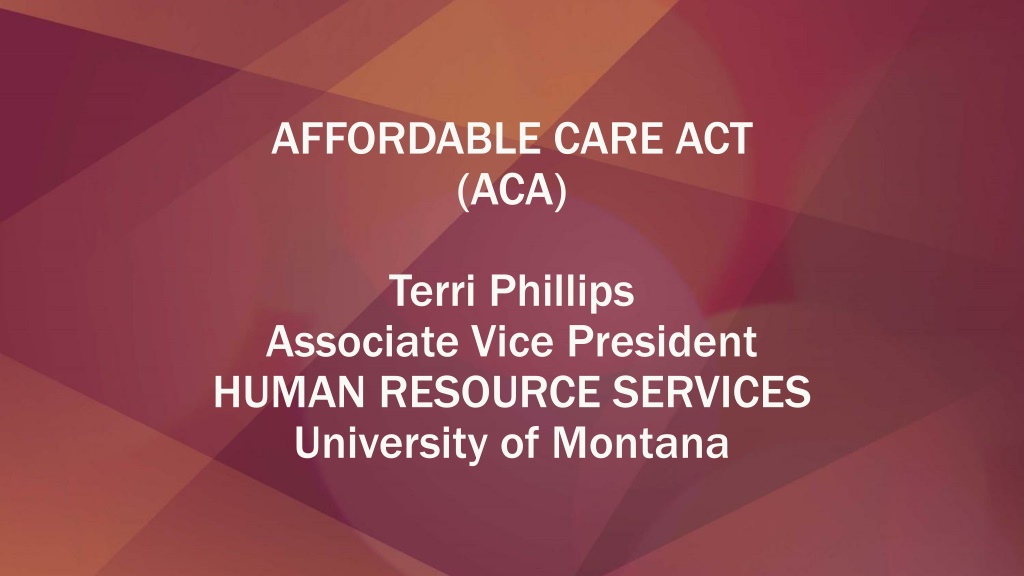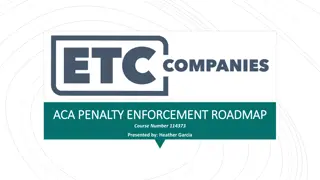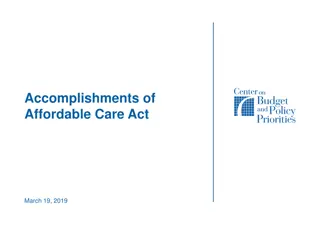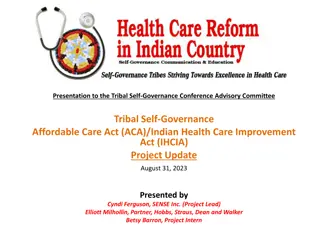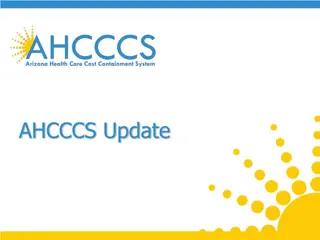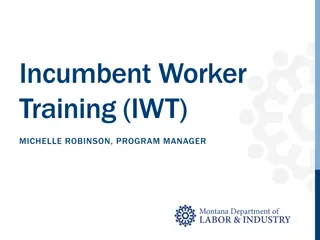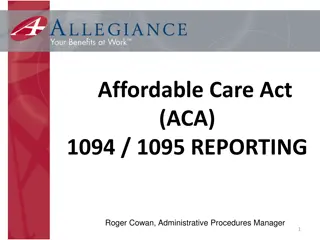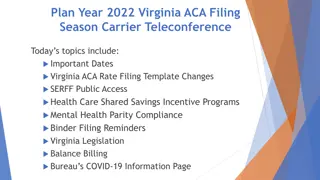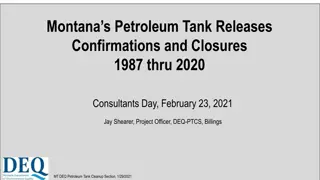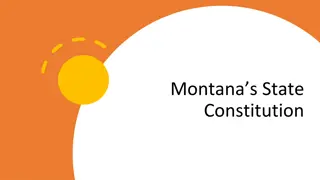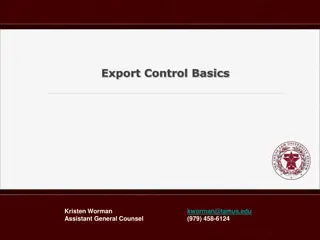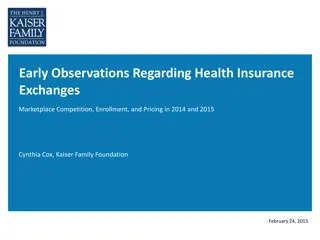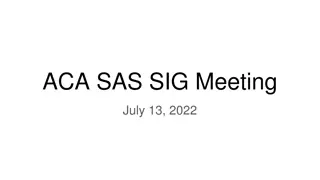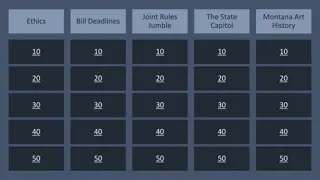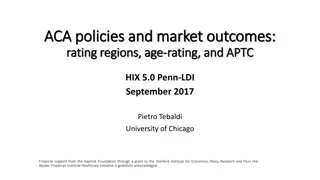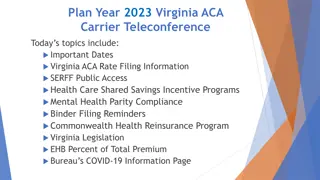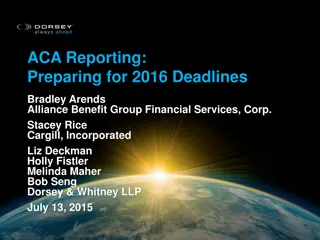Understanding ACA Regulations and Compliance at University of Montana
University of Montana's Human Resource Services manages ACA compliance for its self-funded benefits plan, covering thousands of employees and dependents. The ACA aims to provide insurance coverage to uninsured Americans, with employers playing a crucial role in ensuring compliance with regulations such as offering affordable and comprehensive health insurance. Learn about the ACA purpose, regulations, and defining periods relevant to UM employees.
Download Presentation

Please find below an Image/Link to download the presentation.
The content on the website is provided AS IS for your information and personal use only. It may not be sold, licensed, or shared on other websites without obtaining consent from the author. Download presentation by click this link. If you encounter any issues during the download, it is possible that the publisher has removed the file from their server.
E N D
Presentation Transcript
AFFORDABLE CARE ACT (ACA) Terri Phillips Associate Vice President HUMAN RESOURCE SERVICES University of Montana
Institution Facts University of Montana UM is part of the self-funded benefits plan that the Montana University System maintains with member campuses across the state of Montana. Our self-funded plan covers employees who will work at least a .5 FTE for 6 months or more, with the exception of student employees who do not fall under the MUS Plan. There are approximately 9,000 employees under the MUS benefits plan across the state, with another 9,000 dependents, retirees and COBRA participants. Business Solver produces and mails the Federal 1095 forms to all plan members. Forms must be provided to all active employees, and to those on COBRA coverage and retirees/terminated employees. Employees can download a copy of their form 1095 from the Business Solver website it is not necessary to file this form with the individual tax return.
What is the ACA purpose? The purpose of the Affordable Care Act is to provide insurance coverage for a greater number of uninsured Americans. Employers play a part in this: Employers could be contacted to answer questions about the existence of qualified employer coverage for individuals who have gotten coverage on the Marketplace. Was the employee eligible for employer provided coverage? Was the employee offered coverage under the employer plan? To answer these questions we must have records that provide the detail. UM will most likely hear from the Marketplace Exchange long before we hear from the IRS. The IRS can only begin asking questions after they have received and processed the W2, the 1095, and the Form 1040 it could be 2 years after filing that questions come from the IRS. If you receive questions from any agency regarding coverage please direct them to Human Resource Services for assistance.
ACA Regulations 4980H Title 26 U.S. Code Applicable Large Employers (ALE) must offer health insurance coverage that is : (1) affordable and (2) provides minimum essential value. An applicable large employer is any company or organization that has an average of at least 50 full-time employees or "full-time equivalents" or "FTE. (or an entity that is part of an aggregate group, or control group.) 4980H(c)(4) Full-time Employee An employee who is employed, on average, at least 30 hours/week or 130 hours/month.
ACA Regulations - Defining Periods Initial Measurement Period Covers new hires to determine eligibility. Employees are not eligible for UM health insurance coverage during this time period UNLESS they are working a .5 FTE for 6 months or more. Runs from first day of month after the month of hire for 12 months. For new variable-hour and seasonal employees. Start date varies based on employee s hire date. Standard Measurement Period All employees are evaluated every year from June 1 to May 31.
ACA Regulations Defining Periods Administrative Period period of time for evaluation of hours and offer of coverage to employee Standard Administrative period is June 1st 30th For each new hire it is the 13 month of their employment Stability Period The stability period begins immediately after the administrative period. The employee is counted as eligible based on analysis of measurement period. The stability period is a minimum of 12 months. During the stability period an employee who is eligible for coverage based on the ACA must be offered coverage even if they only work 1 hour in the month.
ACA Regulations - Full-Time Employee The ACA defines an eligible employee as one who averages 30 hours of service per week or 130 hours of service per month MUS method for Determining Full-Time Status if not established at time of hire: Look-back Measurement Period Employee averages 30 hours/week or 130 hours/month over established look-back measurement period.
ACA Regulations Includable Hours Each hour for which the employee is paid, or entitled to payment: For performance of duties For which no duties are performed, including: Vacation, holiday, illness, incapacity (including disability), layoff, jury duty, military leave, leave of absence.
FRINGE ACA Regulations Excludable Hours Worker s Compensation Volunteer employees for tax-exempt organization Students performing work through the federal work study program, state work study or similar program Unpaid Internships Non-US-Source Income Temp Agency Employees
FRINGE ACA Regulations Hours to Count If a break in work service is due to a regular academic year break (winter break, summer break), then this time cannot be counted against the employee in averaging their hours. Employees must have a 26-week break in service in order to be considered a new employee for ACA purposes. Adjuncts must be credited with a minimum of 3.0 hours/credit hour for calculation of ACA eligibility hours. On-call employees credited for any hour of service on-call for which payment is made or due by the employer.
Annual Reporting Requirements Employees will receive: 1095-C from employer what the University must provide to employee by January 31steach year (dates may vary depending on the IRS regulations). IRS will receive: 1094-C from employer what the University must provide to IRS based on filing type.
What comes after you file the 1095s? A Marketplace Notice This document will notify the employer that an employee had been found eligible for subsidy and has enrolled in a qualified health plan through the Marketplace. This notification is supposed to come to the employer in a timely manner and that is the intent for the process moving forward. The intent is that the notification would come to the employer during the marketplace enrollment period so the employer can review, make appeal, and make some change for the employee, if necessary, in regard to employer coverage.
Penalties Employer Shared Responsibility penalty: Employer must offer minimum essential coverage to at least 95% of full-time employees and their dependents: No does not offer > If one full-time employee receives subsidized Marketplace coverage then the penalty = total number of full-time employees (minus 30) times $2,080 (increasing over the years). Yes does offer > If a full time employee receives subsidy on the exchange the penalty is $3,120 annually (increasing over the years) for however many employees got the subsidy.
Hourly EE working all year Hours Year Pay ID Pay# Begin Date End Date Check Date Worked 2020 BW 13 23-May-20 5-Jun-20 17-Jun-20 40 2020 BW 14 6-Jun-20 19-Jun-20 1-Jul-20 80 2020 BW 15 20-Jun-20 3-Jul-20 15-Jul-20 80 2020 BW 16 4-Jul-20 17-Jul-20 29-Jul-20 80 2020 BW 17 18-Jul-20 31-Jul-20 12-Aug-20 80 2020 BW 18 1-Aug-20 14-Aug-20 26-Aug-20 80 2020 BW 19 15-Aug-20 28-Aug-20 9-Sep-20 80 2020 BW 20 29-Aug-20 11-Sep-20 23-Sep-20 80 2020 BW 21 12-Sep-20 25-Sep-20 7-Oct-20 80 2020 BW 22 26-Sep-20 9-Oct-20 21-Oct-20 80 2020 BW 23 10-Oct-20 23-Oct-20 4-Nov-20 80 2020 BW 24 24-Oct-20 6-Nov-20 18-Nov-20 80 2020 BW 25 7-Nov-20 20-Nov-20 2-Dec-20 80 2020 BW 26 21-Nov-20 4-Dec-20 16-Dec-20 80 2020 BW 27 5-Dec-20 18-Dec-20 30-Dec-20 80 2021 BW 1 19-Dec-20 1-Jan-21 13-Jan-21 80 2021 BW 2 2-Jan-21 15-Jan-21 27-Jan-21 80 2021 BW 3 16-Jan-21 29-Jan-21 10-Feb-21 80 2021 BW 4 30-Jan-21 12-Feb-21 24-Feb-21 80 2021 BW 5 13-Feb-21 26-Feb-21 10-Mar-21 80 2021 BW 6 27-Feb-21 12-Mar-21 24-Mar-21 80 2021 BW 7 13-Mar-21 26-Mar-21 7-Apr-21 80 2021 BW 8 27-Mar-21 9-Apr-21 21-Apr-21 80 2021 BW 9 10-Apr-21 23-Apr-21 5-May-21 80 2021 BW 10 24-Apr-21 7-May-21 19-May-21 80 2021 BW 11 8-May-21 21-May-21 2-Jun-21 80 2021 BW 12 22-May-21 4-Jun-21 16-Jun-21 48 2,088 > 1,560 eligible under ACA
Hourly EE with breaks during measurement period. Year Pay ID Pay# Begin Date End Date Check Date Hours 2020 SP 13 23-May-20 5-Jun-20 17-Jun-20 10 2020 SP 14 6-Jun-20 19-Jun-20 1-Jul-20 19 average 2020 SP 15 20-Jun-20 3-Jul-20 15-Jul-20 19 average 2020 SP 16 4-Jul-20 17-Jul-20 29-Jul-20 19 average 2020 SP 17 18-Jul-20 31-Jul-20 12-Aug-20 19 average 2020 SP 18 1-Aug-20 14-Aug-20 26-Aug-20 19 average 2020 SP 19 15-Aug-20 28-Aug-20 9-Sep-20 10 2020 SP 20 29-Aug-20 11-Sep-20 23-Sep-20 58 2020 SP 21 12-Sep-20 25-Sep-20 7-Oct-20 40 2020 SP 22 26-Sep-20 9-Oct-20 21-Oct-20 45 2020 SP 23 10-Oct-20 23-Oct-20 4-Nov-20 30 2020 SP 24 24-Oct-20 6-Nov-20 18-Nov-20 30 Examples for Determining Eligibility 7-Nov-20 20-Nov-20 2020 SP 25 2-Dec-20 10 2020 SP 26 21-Nov-20 4-Dec-20 16-Dec-20 10 2020 SP 27 5-Dec-20 18-Dec-20 30-Dec-20 10 2021 SP 1 19-Dec-20 1-Jan-21 13-Jan-21 19 average 2021 SP 2 2-Jan-21 15-Jan-21 27-Jan-21 19 average 2021 SP 3 16-Jan-21 29-Jan-21 10-Feb-21 19 average 2021 SP 4 30-Jan-21 12-Feb-21 24-Feb-21 10 2021 SP 5 13-Feb-21 26-Feb-21 10-Mar-21 32 2021 SP 6 27-Feb-21 12-Mar-21 24-Mar-21 32 2021 SP 7 13-Mar-21 26-Mar-21 7-Apr-21 32 2021 SP 8 27-Mar-21 9-Apr-21 21-Apr-21 25 2021 SP 9 10-Apr-21 23-Apr-21 5-May-21 40 2021 SP 10 24-Apr-21 7-May-21 19-May-21 60 2021 SP 11 8-May-21 21-May-21 2-Jun-21 30 2021 SP 12 22-May-21 4-Jun-21 16-Jun-21 10 Total Hours Worked 676< 1560Not eligible under ACA
QUESTIONS? Thank you for attending today! You may email Terri.Phillips@umontana.edu with your follow-up questions.
